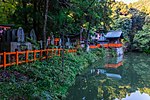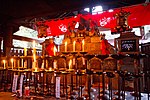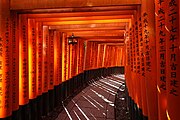Fushimi Inari-taisha
| Fushimi Inari-taisha 伏見稲荷大社 | |
|---|---|
 Torii path with a hanging lantern at Fushimi Inari-Taisha Shrine | |
| Religion | |
| Affiliation | Shinto |
| Deity | Uka-no-Mitama-no-Ōkami, et al. as Inari Ōkami |
| Type | Inari Shrine |
| Location | |
| Location | Fushimi-ku, Kyoto, Kyoto, Kyoto Prefecture, Japan |
 Shown within Kyoto city | |
| Geographic coordinates | 34°58′2″N 135°46′22″E / 34.96722°N 135.77278°E |
| Architecture | |
| Date established | 711 |
| Website | |
| inari | |
Fushimi Inari-taisha (伏見稲荷大社) is the head shrine of the kami Inari, located in Fushimi-ku, Kyoto, Kyoto Prefecture, Japan. The shrine sits at the base of a mountain also named Inari which is 233 metres (764 ft) above sea level, and includes trails up the mountain to many smaller shrines which span 4 kilometres (2.5 mi) and take approximately 2 hours to walk up.[1]
Inari was originally and remains primarily the kami of rice and agriculture, but merchants and manufacturers also worship Inari as the patron of business[citation needed]. Each of Fushimi Inari-taisha's roughly thousand torii was donated by a Japanese business.
Owing to the popularity of Inari's division and re-enshrinement, this shrine is said to have as many as 32,000 sub-shrines (分社 bunsha) throughout Japan.[2]
History[]








The shrine became the object of imperial patronage during the early Heian period.[3] In 965, Emperor Murakami decreed that messengers carry written accounts of important events to the guardian kami of Japan. These heihaku were initially presented to 16 shrines, including the Inari Shrine.[4]
From 1871 through 1946, Fushimi Inari-taisha was officially designated one of the Kanpei-taisha (官幣大社), meaning that it stood in the first rank of government supported shrines.[5]
Structures[]
The earliest structures were built in 711 on the Inariyama hill in southwestern Kyoto, but the shrine was re-located in 816 on the request of the monk Kūkai. The main shrine structure was built in 1499.[6] At the bottom of the hill are the main gate (楼門, rōmon, "tower gate") and the main shrine (御本殿, go-honden). Behind them, in the middle of the mountain, the inner shrine (奥宮, okumiya) is reachable by a path lined with thousands of torii. To the top of the mountain are tens of thousands of mounds (塚, tsuka) for private worship.
Senbon Torii[]
The highlight of the shrine is the rows of torii gates, known as Senbon Torii. The custom to donate a torii began spreading from the Edo period (1603 – 1868) to have a wish come true or in gratitude for a wish that came true. Along the main path there are around 1,000 torii gates.
Fox[]
Foxes (kitsune), regarded as the messengers, are often found in Inari shrines. One attribute is a key (for the rice granary) in their mouths.
Unlike most Shinto shrines, Fushimi Inari-taisha, in keeping with typical Inari shrines, has an open view of the main object of worship (a mirror).
A drawing in Kiyoshi Nozaki's Kitsune: Japan's Fox of Mystery, Romance and Humor in 1786 depicting the shrine says that its two-story entry gate was built by Toyotomi Hideyoshi.
The shrine draws several million worshipers over the Japanese New Year, 2.69 million for 3 days in 2006 reported by the police, the most in western Japan.

Fox holding a key in its mouth, at the main gate of the Fushimi Inari shrine

Fox holding a jewel in its mouth at the main gate of the Fushimi Inari shrine

Fox sculpture in Fushimi Inari-taisha shrine

Fox fountain in Fushimi Inari-taisha shrine

Another view of the fox fountain

Fox altar in Fushimi Inari-taisha shrine
Access[]
The shrine is just outside the Inari Station on the Nara Line of the West Japan Railway Company (JR), a five-minute ride from Kyoto Station. It is a short walk from Fushimi-Inari Station on the Main Line of the Keihan Electric Railway.[7]
The shrine is open 24 hours with both the approach to the shrine and the Honden (本殿, main hall) itself illuminated all night. There is no entrance fee.
Environs[]
In the approach to the shrine are a number of sweet shops selling tsujiura senbei (辻占煎餅), a form of fortune cookie dating at least to the 19th century, and which are believed by some to be the origin of the American fortune cookie.[8][9][10]
In popular culture[]
This article is in list format, but may read better as prose. (June 2017) |
- Memoirs of a Geisha (2005)
- Aria the Natural ep. 5 (2006)
- Inari, Konkon, Koi Iroha (2010)
- Rurouni Kenshin, site of Makoto Shishio's base
- Kamen Rider Fourze ep. 33 (2012)
- Samsara (2011 film) (2011)
- High School Inari Tamamo-chan' ', where the main character a fox spirit came from along with her siblings.
A part of the Noh play Kokaji takes place in Fushimi Inari-taisha.[11]
Image gallery[]

View of the south-western wing of Senbon Torii path.

View of the north-eastern wing of Senbon Torii path.
See also[]
References[]
Citations[]
- ^ 全国のお稲荷さんの総本宮、伏見稲荷大社を参拝しました。 [Nationwide Inari Shrines, I visited the Fushimi Inari-taisha.] (in Japanese). Retrieved 28 March 2014.
- ^ Motegi, Sadazumi. "Shamei Bunpu (Shrine Names and Distributions)". Encyclopedia of Shinto. Retrieved 31 March 2010.
- ^ Breen, John et al. (2000). Shinto in History: Ways of the Kami, pp. 74-75.
- ^ Ponsonby-Fane, Richard. (1962). Studies in Shinto and Shrines, pp. 116-117.
- ^ Ponsonby-Fane, Richard. (1959). The Imperial House of Japan, pp. 124.
- ^ Nussbaum, Louis-Frédéric et al. (1998). Japan encyclopedia, p. 224.
- ^ Fushimi Inari Shrine, How to get there
- ^ Lee, Jennifer 8. (January 16, 2008). "Solving a Riddle Wrapped in a Mystery Inside a Cookie" The New York Times. Retrieved on January 16, 2008.
- ^ 8. Lee, Jennifer (January 16, 2008). "Fortune Cookies are really from Japan". The Fortune Cookie Chronicles. Archived from the original on 2011-07-25.
- ^ Ono, Gary (2007-10-31). "Japanese American Fortune Cookie: A Taste of Fame or Fortune -- Part II".
- ^ "Kokaji (pamphlet)" (PDF). noh-kyogen.com. Retrieved 2018-01-09.
Bibliography[]
- Breen, John and Mark Teeuwen. (2000). Shinto in History: Ways of the Kami. Honolulu: University of Hawaii Press. ISBN 978-0-8248-2363-4
- Nussbaum, Louis-Frédéric and Käthe Roth. (1998). Japan encyclopedia. Cambridge: Harvard University Press. ISBN 978-0-674-01753-5
- Ponsonby-Fane, Richard. (1962). Studies in Shinto and Shrines. Kyoto: Ponsonby Memorial Society. OCLC 399449
- Ponsonby-Fane, Richard (1959). The Imperial House of Japan. Kyoto: Ponsonby Memorial Society. OCLC 194887
- Smyers, Karen A. (1997). Inari pilgrimage: Following one’s path on the mountain, Japanese Journal of Religious Studies 24 (3-4), 427-452
External links[]
| Wikimedia Commons has media related to Fushimi Inari-taisha. |
- Official Site (in Japanese)
- Official Site (in English)
- Photographs of Fushimi Inari-taisha
- Accessibility information
- 96291583 Fushimi Inari-taisha on OpenStreetMap
Coordinates: 34°58′02″N 135°46′22″E / 34.96722°N 135.77278°E
- Important Cultural Properties of Japan
- Inari shrines
- Shinto shrines in Kyoto










